Fiberglass Reinforced Plastic: High Performance in Ceiling and Wall Panels
Commercial applications benefit from cost-effective materials that stand up to harsh conditions.
![]() Continuing Education
Continuing Education
Use the following learning objectives to focus your study while reading this month’s Continuing Education article.
Learning Objectives - After reading this article, you will be able to:
- Explain the composition of Fiberglass Reinforced Plastic (FRP) composites.
- Distinguish between thermoset and thermoplastic materials in the building environment.
- Describe the benefits of FRP versus other common building materials.
- Understand where to specify FRP.
When it comes to selecting the right building material for the project at hand, architects have many options. Natural materials like wood, metal and stone may be right when beauty and durability are key. But manmade materials also have their place, particularly when cost and ability to stand up to demanding environments are critical design considerations. Technology has enabled the production of fiber-reinforced plastics (FRP) to provide the characteristics needed to simulate - and often surpass - many of the performance characteristics of traditional materials. Just as durable, frequently stronger and typically more cost effective, lighter, easier to clean and install, FRP has a 60-year track record as solutions for industrial and commercial challenges, particularly those with corrosive environments. This article will serve as a primer on FRP ceiling and wall panels, discussing their properties, how they are made, and their appropriate applications.
FRP - The Basics
While many plastics are pure plastics, there are also plastic composites. Plastics can be reinforced when additional strength is needed, usually with reinforcing fibers. The combination of plastic and reinforcement produces some of the strongest materials for their weight ever made. An FRP composite is actually a combination of a polymer matrix and a reinforcing agent such as glass, carbon, or aramid (a class of heat-resistant and strong synthetic fibers), so that there is a length to thickness ratio that provides a reinforcing function.
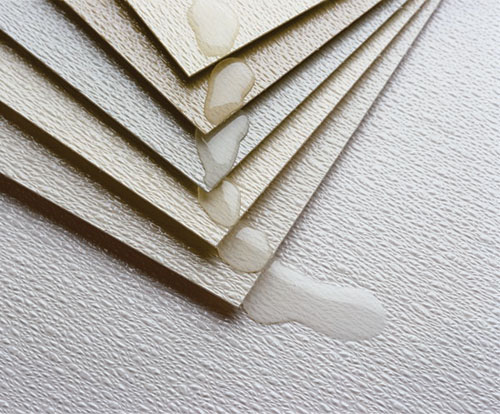 |
Photo: Crane Composites, Inc. |
The resin protects the fibers, maintains their alignment, and distributes the loads evenly among them. The FRP composite may also contain fillers, additives and core materials. None of the elements in a composite dissolve or merge completely into each other, but act together to offer benefits ideal for structural applications. The FRP significantly increases the members' load carrying capacity. According to the American Composites Manufacturing Association, FRP composites deliver more strength per unit of weight than most metals and are 1/5th the weight of steel.
Fiberglass. Many FRP panels are made from a polyester resin with a chopped glass fiber reinforcement. Chopped glass is used because of its added cross-directional reinforcement.
Fiberglass fibers are made from molten glass extruded at a specified diameter. The fibers are gathered into bundles and the bundles combined create a roving. Rovings are a continuous rope, similar to twine, and are wound on a mandrel to form a ball called a doff. Reinforcements for FRP are made from rovings that are either chopped into short strands or woven into a cloth.
There are many factors that affect the reinforcement characteristics of fiberglass:
- Fiber and bundle diameter and type of glass
- Direction of the fiberglass reinforcement
- The amount of fiberglass reinforcement
- The physical contact (wetout) of the fiber with the polymer
All of these factors must be taken into account when designing an FRP composite so that the required physical property strengths are met.
 |
|
Photo: Crane Composites, Inc. FRP panels are commonly found in the food preparation area of many restaurants. |
Plastics/Polymers.There are two basic types of plastics/polymers: thermoplastic and thermoset. In general, FRP composites utilize a thermoset plastic, and are not to be confused with a thermoplastic, which is a plastic material that can be readily softened and reformed by heating and rehardened by cooling.
A plastic in which the polymer molecules are not crosslinked (not chemically bonded to other polymer molecules) is a thermoplastic. Since the molecules are not connected by crosslinks, it allows the molecules to spread farther apart when the plastic is heated. This is the basic characteristic of a thermoplastic; the plastic will soften, melt, or flow when heat is applied. Melting the plastic and allowing it to cool within a mold will form the finished product. Typical thermoplastics are: polyethylene (PE) - used in making garbage bags; polyvinyl chloride (PVC) - used for house siding; and polypropylene (PP) - used as carpet fibers, packaging, and diapers.
A plastic in which the polymer molecules are crosslinked (chemically bonded) with another set of molecules to form a "net like" or "ladder-like" structure is a thermoset plastic. Once crosslinking has occurred, a thermoset plastic does not soften, melt, or flow when heated. However, if the crosslinking occurs within a mold, the shape of the mold will be formed. Typical thermoset plastics are: unsaturated polyester (UP) -used for bowling balls and boats; epoxy− used for adhesives and coatings; and polyurethanes (PURs) - used in foams and coatings.
Many FRP wall and ceiling panels are made of thermoset plastic, that is, a material that undergoes a
chemical reaction in which it is formed into a solid and cannot be reformed. By reinforcing the plastic matrix, a wide variety of physical strengths and properties can be designed into the FRP composite. Additionally, the type and configuration of the reinforcement can be selected, along with the type of plastic and additives within the matrix. FRP composites can be developed specifically for the performance required versus traditional materials such as wood, metal, ceramics, and the like. A key advantage of FRP is that engineers can design the FRP composite to provide the needed characteristics, and avoid cost penalties of an over-engineered product.
 |
|
Food processing requires the rugged performance of FRP panels. Photo: Crane Composites, Inc. |
A thermoset FRP wall panel provides a long-term, durable, sanitary finish that meets the rugged performance needed in food processing, health care and storage environments. The primary advantage of this type of FRP panel is its long-term resolution of these performance needs.
On the other hand, non-reinforced thermoplastic panels such as those made of PVC, PE or PP, or combinations thereof, may be lower in cost but have inferior performance characteristics. Because of their lack of reinforcement, they are particularly difficult to install properly. Both PE- and PP-based panels may be more difficult to use with water-based latex adhesives because of high-surface tension properties. That is, during installation, latex adhesives can tend to "bead" and resist spreading, possibly causing delamination early after installation. The high surface tension, combined with thermal expansion up to three times higher than that of FRP panels, can cause bubbles and bulges in wall panels within weeks of installation. Further, only a small temperature change will result in a relatively large expansion of the non reinforced thermoplastic panels-a property that will cause failure and need for replacement in refrigerated and cooking areas.
The soft surface of the thermoplastics makes them poor performers in cleanability and abrasion. Surface hardness tests show that FRP panels are over three times harder than non-reinforced thermoplastics which tend to stain easily and become difficult to clean. This applies to graffiti, food stains and yellowing and color change. In terms of durability, the thermoplastic panels display only 24 percent of the stiffness provided in FRP panels. While often touted as environmentally friendly, non-reinforced thermoplastics contain a small percentage of recycled plastic. The higher the recycled plastic component, the lower the performance characteristics, and use of recycled content contributes to premature aging and yellowing.
In selecting thermoset FRP panels, which have no recycled plastic at this point, architects should note that they do vary in strength based on the amount of fiberglass reinforcement. Less expensive panels tend to have less reinforcement. The panels are generally utilitarian, rather than aesthetic, and have a tendency to yellow with age, though this can be somewhat offset by use of a special sealant. An installation crew experienced with FRP panels is advisable.
The Manufacturing Process |
 |
|
Photo: Crane Composites, Inc. Chopped fiberglass is laid onto the resin and film. |
In making the fiberglass-reinforced plastic panels, first fiberglass is fed into the machine. Glass doffs provide the reinforcement. Embossed film is fed into the process, and resin poured onto the polyester film. Chopped fiberglass is laid onto the resin and film. The panel is cured prior to trimming, which is done by water jets. Finished panels are then inspected for quality and packaged, ready to be shipped to a job site. |
FRP Ceiling and Wall Panel Applications
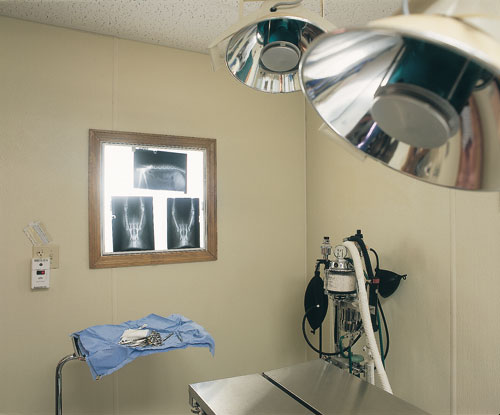 |
Photo: Crane Composites, Inc. FRP panels can be used in many settings, including schools, restrooms or veterinary hospitals. |
FRP wall and ceiling panels are widely used throughout the construction and building materials industries. They are used extensively in commercial applications such as food, meat and dairy processing plants, labs and clean rooms, refrigerated warehouses, and chemical processing plants. FRP panels are also appropriate for restaurant kitchens, public washrooms, super markets and high traffic areas. Because of their sanitary properties, FRP panels are also used in the health care industry from nursing homes and day care centers and in educational settings from dormitories to schools and locker rooms.
Manufacturers offer a range of products to meet diverse design objectives. Lightly textured or high-gloss gel coat FRP panels can be used in "front room" areas where a sanitary and durable yet aesthetically pleasing finish is needed, as in an educational or public setting. FRP panels can also be laminated to a rigid substrate such as gypsum, plywood, fluted polypropylene, or oriented strand board, providing added structural strength and rigidity and allowing installation directly to studs on the wall or ceiling.
For "back room" areas where a sanitary and durable finish that meets USDA/FSIS requirements is required, FRP wall and ceiling panels can be sealed with a special protective finish that enhances their cleanability by ensuring that the panels remain mold and mildew free and moisture resistant. Such sealed panels have applicability in major restaurant chains where standardization is an important element of productivity and cost control. For example, every new and remodeled kitchen in the Pizzeria Uno eatery chain features smooth FRP panels with special sealants. Scot Durkin, Uno Restaurant Corporation's Director of Construction explains that the 2' x 2' panels with the special sealant will ultimately replace tile ceilings in every Pizzeria Uno kitchen. "In terms of washability the panels are superior to tile because there are far fewer cracks and seams in the ceiling," says Durkin, noting that the panels are "much easier and less costly to install." In addition, the treated FRP panels clean easily while retaining mildew resistance and corrosion prevention capabilities. Their smooth finish reflects the light, which brightens up the kitchens. Durkin reports that the specially treated Class C ceiling panels meet all Pizzeria Uno architectural specifications.
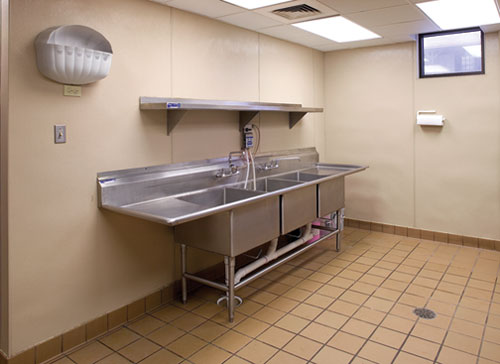 |
Photo: Crane Composites, Inc. FRP is found in the kitchen areas of restaurants. |
Similar surface-treated FRP panels were listed as "no substitutions allowed" by B.I. Concept Systems, the franchise consulting and equipment services firm responsible for establishing construction standards for the washrooms and back room food preparation areas of Blimpie International's new franchise operations. Robert O. DeVillier III, Assistant Vice President Design for B.I. Concept Systems, claims the decision to replace standard FRP panels with the surface-treated version came down to quality. "According to the test samples we ran, the treated panels held up substantially better than competitive FRP," he says. "And because it's not as porous it offers a better solution for our sanitation needs."
Strict sanitation requirements and low maintenance are among the highest priorities for Rhodia, Inc., which serves the food industry as a primary source of bacterial starter cultures, enzymes and natural food colors. Rhodia used treated FRP panels for a multimillion dollar addition to its Madison, Wisconsin, plant. Some 800 sheets of specially treated panels were used, in 4' x 8' and 4' x 10'panel sizes. Standard panels were specified for most of the facility, and Class A fire-rated FRP panels were selected for "at risk" production areas. "Since production areas are thoroughly disinfected and hosed down on a shift-by-shift basis, cleanability is one of our major concerns," says Rod Dahlen, Rhodia Plant Manager. "Unlike a painted wall, the treated, non-porous FRP product does not harbor microorganisms."
Also available are FRP composite ceiling grid systems with improved fastening systems. The University of Connecticut at Storrs used such an improved FRP ceiling grid system on its new Agricultural and Biotech Building. Unlike many box-shaped university facilities, this building features a unique circular design with pie shaped rooms that required close attention to dimensions and ceiling grid layout. While fiberglass ceiling grid systems have traditionally been used because of their performance characteristics, they are sometimes cumbersome and time-consuming to install because of excessive amount of clips necessary to hold the system together. UCONN opted for an improved FRP ceiling grid with the traditional performance characteristics but with a notched locking mechanism that reduced the need for so many clips and made the entire grid system more stable. The main tee notches were positioned every six inches for cross tee connection, eliminating the need for junction clips that made the installation of the Class A fire-rated FRP 2' x 4' panels easier vs. the standard system which require the ceiling panel to be flexed in order to fit properly under the hold-down clips. The new system was "both faster and easier to install," says Bill DeMeola, Vice President of Thermal Fireproofing and Acoustics Company in West Haven, Connecticut, which installed the ceiling. DeMeola credits the new system with cutting installation labor time by up to one half.
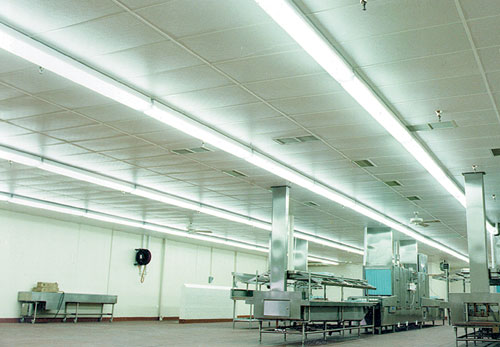 |
Photo: Crane Composites, Inc. Food processing area with FRP ceiling panels and a suspended fiberglass ceiling grid system |
FRP Properties
Strength
FRP composite panels have a high strength-to-weight ratio and are not susceptible to scratching or denting. They are impervious to most mild acids, and will not rot, corrode, stain, peel, or splinter. Generally, FRP panel strength is unaffected by a wide range of temperatures, (-65 °F to 135 °F).
FRP panels are used in designs where a certain measure of strength or modulus of elasticity is required that non-reinforced plastics or alternative materials cannot match either mechanically or economically. As has been mentioned, FRP products are extremely durable compared to many traditional products as the thermosetting resin properties provide chemical, moisture, and temperature resistance, while the fiberglass reinforcement increases strength and provides good performance over a wide temperature range versus thermoplastics which are greatly affected by temperature.
The properties of FRP composites are measured the same way that traditional materials are measured so that comparisons can be made for evaluation. Typical measurements include:
- Compressive strength. Describes how much of a load a material can take before it is crushed or fractured
- Flexural modulus. A number associated with the flexibility or stiffness of a material. It indicates how far a material will bend when a certain load is applied to it. The lower the modulus, the more flexible the material. ASTM D790
- Flexural strength.Measures how much of a load a material can take before it fractures or breaks when it is in the process of being bent. Higher numbers indicate stronger materials that can withstand a heavier load before breaking. ASTM D790
- Impact strength. There are two primary impact tests; one is called IZOD impact and the other is called Gardner impact. IZOD impact measures the energy required to fracture or break a material when it is struck on its edge. Gardner impact measures the energy required to damage or puncture a material when it is struck on its front surface.
- Rockwell or barcol hardness. Measures the surface hardness of a material. A steel point is forced into the material and its resistance to penetration measured. The higher the hardness value, the more resistant a material is to scratching, abrasion, and denting. ASTM D785
- Tensile modulus. A number associated with pulling or stretching a material (tension) and how much it elongates when a certain load is applied to it. The lower the modulus, the more the material will elongate or stretch. ASTM D790
- Tensile strength. Measures how much of a load a material can take before it fractures or breaks when it is in the process of being stretched. Higher numbers indicate materials that can withstand a stronger pull before breaking. ASTM D790
Mold-, Mildew-, Stain- and Bacteria-resistant
Per ASTM D373 or D3274, FRP panels do not support mold or mildew as do wood and paper-faced drywall. The panels are moisture resistant and easy to clean, and can withstand repeated cleanings without surface deterioration.
 |
Photo: Crane Composites, Inc. |
FRP finishes can be either smooth or embossed. Testing has shown that either finish cleans up as well as a #3 finish on stainless steel. Tests for bacteria and mold growth, including those conducted by ASTM D3273 and D274 indicate that FRP composites do not support the growth of either.
Some practitioners maintain that an embossed finish has the added benefit of providing a more scuff-resistant surface than a smooth panel. Independent testing by New Zealand-based Mirinz Laboratories of an embossed FRP finish versus a smooth finish at a meat processing facility indicated that over the four week period, "bacterial counts at all levels (eye, waist and knee) were generally within the Mirinz guidelines and found to be no higher in bacteria counts than that of the existing stainless steel and smooth plastic panels." Embossed panels are also applicable in corrosive environments as they have a good track record in cleanability and abrasion resistance. Each bump on the surface face is a solid resin mix. Any abrasion sustained is concentrated on the "bump," protecting the panel itself from abrasion and exposure to bacteria or stains.
Low Maintenance
FRP composite panels do not need painting and require little in the way of maintenance. Cleaning FRP wall or ceiling panels on a regular basis with a mild non-abrasive cleaner is recommended so that soil and dirt will not build up. A 5 to 10 percent trisodium phosphate water solution not to exceed 130°F (55°C) can be used. If trisodium phosphate is not available, a 5 to 10 percent solution of household automatic dishwasher detergent should be used. If a USDA or FDA approved cleaner is required, a neutral cleaner (pH range 6.5 - 7.5) is preferred. In all cases, the manufacturer's directions should be followed.
FRP panels can best be cleaned with a sponge or soft brush. Wire brushes or other abrasive tools or pads will scratch the surface. Apply the cleaner, working it across the surface in a scrubbing or circular motion. Rinse thoroughly to remove all traces of the cleaner; otherwise a film will build up giving the panel a dull, dirty appearance. When using a specialty cleaner, follow the manufacturer's instructions. Test a small area before applying over the entire surface.
To clean hard water deposits, a 10 percent solution of acetic acid in cold water should be used according to the same cleaning procedures outlined above. If the panel surface becomes dull or abraded, complete cleaning may not be possible. FRP panels can withstand repeated cleanings without adverse effect.
Ease of Installation
FRP panels feature a relatively easy installation. They adhere with adhesive or mechanical fasteners with common carpenter's tools sufficient for most installations. FRP is also easy to field cut and can be installed over drywall or other flat, dry surfaces in both renovation and new construction projects. Wall and ceiling panels can be installed directly over ceramic tile. Non-porous surfaces require the use of rivets unless the surface of the tile is opened by sanding or use of chemical abrasive. Adhesive should be used on porous surfaces only. For installation over concrete block, uneven surfaces must be leveled with plaster or concrete compounds. Concrete walls must be well cured and completely dry. If concrete or block walls are below grade where moisture can penetrate and interfere with a good adhesive bond, furring strips should be used and pre-laminated panels installed with mechanical fasteners. The panels are resistant to shrinkage and expansion due to moisture.
To be used with gypsum wallboard and plywood substrates, VOC-compliant adhesives have been specifically formulated for the installation of FRP panels with the "fast grab" and bonding power that greatly reduce the need for extended bracing. Many of these adhesives contain no ozone-depleting chemicals. Unlike solvent-based adhesives, they are nonflammable, emit no harmful fumes and clean up with water. Some of these adhesives exceed the ASTM C557 specification, and provide water resistance while remaining permanently flexible. They are easy to trowel and offer a 30-minute working time to allow precise placement of the working materials.
Decorative Appeal
Traditionally, FRP wall panels were used in back rooms, such as kitchens, storage and non-public areas in commercial facilities. Now they are available in various patterns, textures and colors that are appropriate for dining rooms, lobbies and other front of house areas. Manufacturers' palettes include FRP panels made to simulate the look of tile, as well as in sandstone, linen, cedar, beaded and pebble embossed surfaces.
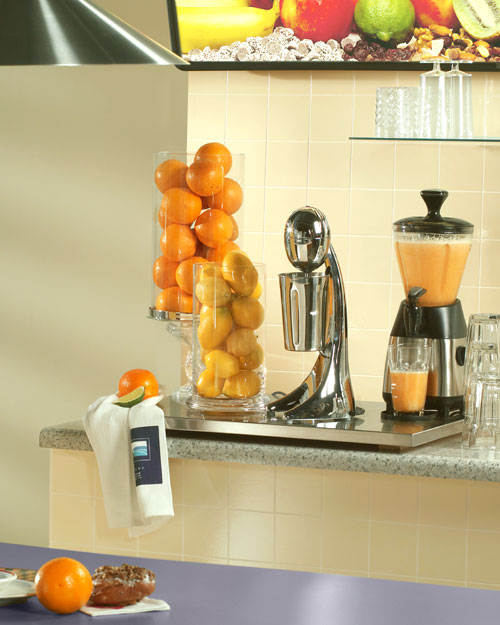 |
|
Photo: Crane Composites, Inc. FRP panels present an attractive, sanitary surface. |
FRP versus Other Materials
FRP compares favorably to other materials in a number of respects:
Ceramic tile. Tile must be cleaned at a greater frequency than FRP panels. With tile, dirt, mildew and staining in the grout lines are common. Tiles can also crack and shatter and can be difficult to replace. Usually ceramic tiles cost twice as much as FRP materials.
Stainless steel. This material dents easily upon impact and its surface shows any abrasion marks. Stainless steel is susceptible to corrosion in certain environments and can be twice the price of FRP.
Drywall. Difficult to clean and requiring frequent repainting, drywall also has a relatively low impact strength compared to FRP. In addition, drywall has poor resistance to water and moisture and is therefore susceptible to mold and mildew.
Photo: Crane Composites, Inc.
Drywall is difficult to clean.
Concrete block. Concrete block is porous and must therefore be sealed or painted often. It is difficult to clean and is not USDA-compliant.
Epoxy paint. Epoxy paint involves a labor intensive installation process and after installation it has high maintenance requirements. Epoxy paint is not impact or abrasion resistant and it is easily affected by moisture and chemicals.
Vinyl wall coverings.Vinyl wall coverings are expensive and difficult to install. They are not impact or abrasion resistant and tend to show imperfections below the surface.
Specification Considerations
Architects should consider the following parameters when specifying FRP ceiling and wall panels:
Thickness. A standard FRP textured panel is .09 inches thick
Weight. A standard FRP panel generally weighs .7lb/per square foot
Flame and smoke rating. Like other organic building materials (e.g., wood), products made of FRP resins will burn. When ignited, FRP may produce dense smoke very rapidly. All smoke is toxic. Fire safety requires proper design of facilities and fire suppression systems, as well as precautions during construction and occupancy. Local codes, insurance companies and any special needs of the product user will determine the correct fire-rated interior finish and fire suppression system necessary for a specific installation.
FRP can be modified with additives to meet the code requirements of the particular application. One common testing method for building materials is the ASTM-E84 "Tunnel Test" in which the flammability and smoke development are measured and indexed against the performance of Red Oak in the same test. ASTM E-84 is the standard test method for surface burning characteristics of building materials and applicable to exposed surfaces for ceilings and walls. Class A ratings indicate a flame spread of 25 or less, and a smoke density of 450 or less. Less stringent Class C ratings indicate a flame spread between 76 and 200, and smoke development of 450 or less. It's important to note, however, that numerical flame spread and smoke development ratings are not intended to reflect hazards presented by FRP products or any other material under actual fire conditions. These ratings are determined by small-scale tests conducted by Underwriters Laboratories and other independent testing facilities using the American Society for Testing and Materials E-84 test standard. These ratings should be used for material comparison purposes only.
Factory Mutual approved FRP panels pass a more stringent fire test than the standard ASTM E-84 requirements. For strictest fire standards, architects should look for FRP panels with an FM-approved test report "#2B2A2.AM," as opposed to the ASTM E-84 reports.
Resistance to abrasion. Resistance to abrasion is defined as the ability of a material to withstand mechanical action such as rubbing, scraping, or erosion. Abrasion can be difficult to compare but haze variation or weight loss are often evaluated. For FRP wall or ceiling panels the measurement is the Taber Abrasion Resistance test.
Special codes. Architects should note that FRP panels to be used in food processing environments should meet the requirements of the Food Service Inspection Service of the U.S. Department of Agriculture. Other codes that may have bearing on an FRP installation would include the New York City Materials and Equipment Acceptance code, the City of Los Angeles codes and the International Codes, or I-Codes, published by ICC, that provide minimum safeguards for people at home, at school and in the workplace. The I-Codes are a complete
set of comprehensive, coordinated building safety and fire prevention codes. Building codes benefit public safety and support the industry's need for one set of codes without regional limitations. Fifty states and the District of Columbia have adopted the I-Codes at the state or jurisdictional level.
Daylighting Panels |
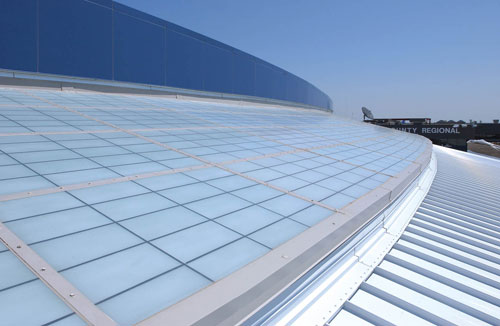 |
Photo: Major Industries |
FRP panels using an advanced polymer resin system with UV inhibitors and color stabilizers can offer good weathering performance in curtain wall, metal building |
Environmental Considerations
Architects interested in specifying products that are as environmentally sound as possible should look to how manufacturers approach waste reduction and recycling. Manufacturers of FRP panels can implement production efficiencies and reduction in reject that can reduce land fill waste substantially. One manufacturer produced 9.7 million or 36 percent less square feet of scrap, that would have been sent to the landfill. This substantial reduction was accomplished by narrowing the amount of edge trim inherent in the process, developing quicker changeovers between production runs, reducing reject caused by material thickness tolerance variances, and demanding consistent raw material quality from vendors. A method known as Single Minute Exchange of Die (SMED), a lean production method, also reduces waste in a manufacturing process by providing a rapid and efficient way of converting a manufacturing process from running the current product to running the next product.
Manufacturers can also slate material that does not meet first pass yield quality inspection to be reworked into smaller sizes or alternate application uses. In addition, manufacturers can participate in programs for landfill avoidance - programs that promote waste prevention, recycling or composting.
Controlling VOCs
Environmentally responsible manufacturing facilities utilize state of the art Regenerative Thermal Oxidizers (RTOs) to eliminate the emission of Volatile Organic Compounds (VOCs), making their production facilities compliant. Thermal oxidizers destroy air toxins and VOCs that are discharged in industrial process exhausts. RTOs achieve VOC with Maximum Achievable Control Technology (MACT) regulations destruction through the process of high temperature thermal oxidation. The RTO process which eliminates VOCs also generates energy that can be used to heat the manufacturing facilities. Recycled water can be used to provide the manufacturing process equipment cooling. This closed loop system prevents thousands of gallons of water from going down the drain every day.
Recycling
FRP share issues and concerns surrounding plastic waste disposal and recycling. Because they are derived from polymers and monomers that often cannot be separated and returned to their virgin states, plastics are challenging to recycle. Not all plastics can be recycled for re-use. Some experts claim only 20 to 30 percent of plastics can be material recycled at all. Beyond those concerns, FRP contain fibers that are difficult to remove from the matrix and preserve for re-use. In short, FRP are inherently difficult to separate into fiber and matrix, and the matrix itself is challenging to divide into separate usable plastic, polymers, and monomers. However, it should be noted that FRP often offer savings in energy and cost in comparison to other materials, and their durability precludes the necessity of frequent replacement - all of which have environmental value. With the advent of new more environmentally friendly matrices such as bioplastics and UV-degradable plastics, FRP stand to increase their sustainability quotient.
High-performance Panels
For wall and ceiling panels used in harsh back room environments or in front of house situations where an attractive, sanitary surface is desired, FRP are a solution that is economical and reliable. FRP can be an important part of an architect's palette in designing high-performance, low-maintenance commercial applications.
|


